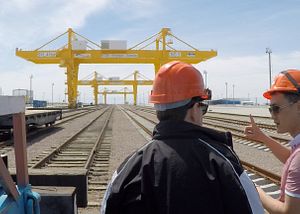Some weekend reading:
The NYT Goes to Kazakhstan: Andrew Higgins, a Moscow correspondent for The New York Times, must have just returned from a trip to the steppe, as the NYT recently published two articles about Kazakhstan. One focused on a gradually vanishing piece of Kazakhstan’s past and the other on a promised, gleaming, future.
Higgins delved into the lives of Kazakhstan’s cowboys. The article largely hones in on Erlan Kozhakov, a 63-year-old herder in southeastern Kazakhstan. Kozhakov’s wife, we find out, was kidnapped by her husband and forced into the marriage. The issue of bride kidnapping is, as Higgins notes, a “touchy subject.” Of their six children, only one works as a cowboy.
Kozhakov and the cowboys, Higgins writes in a perfect encapsulation of Kazakhstan’s cultural conundrum, “represent the last remnants of a vanished past that Kazakhstan… both celebrates and desperately wants to escape.”
At the other end of the past-future spectrum, Higgin also penned a piece on the Khorgos Gateway, Kazakhstan’s key node on the Chinese Belt and Road. The article, somewhat oddly, frames the 2015 formulation of the Eurasian Economic Union as a “big boost” to what was initially called the “Silk Road Economic Belt” before morphing into what China now calls the Belt and Road Initiative (BRI). Saying “Mr. Putin’s union has allowed cargo trains and trucks from Kazakhstan to pass into Russia without laborious customs inspections” is technically true, but in practice that just means the customs inspections happen at the Kazakh border instead.
Importantly, despite the hype about the BRI in Central Asia, this tidbit is illuminating (emphasis added):
In 2017, Khorgos handled the equivalent of more than 100,000 standard containers full of goods, double what it handled last year. It aims to handle 500,000 containers by 2020, but even that target is only around 1 percent of the volume of goods that travel from Asia westward by sea.
Kazakhstan’s dry port may be making progress, but it’s no substitute for the sea.
Envisioning the Silk Road: The New Yorker, not to be left out I suppose, also highlighted the Belt and Road in early January with a portfolio of photos from photographer Davide Monteleone’s fall journey from Yiwu in southeastern China to Khorgos and then on to Aktau on the banks of Caspian Sea. The images are the real gems but one observation is worth nothing: “Few of the Chinese whom Monteleone encountered, from shopkeepers to restaurant owners to railwaymen, had much interest in the Belt and Road Initiative.” More immediate concerns — “[W]hat puts money in our pocket tomorrow…” one Chinese worker said — trump the grand plan and promised future payoffs.
A Tajik Couple and Their Swanky Czech Properties: The Organized Crime and Corruption Reporting Project (OCCRP) released a damning report this week catching the former head of Tajik Railways in an apparent lie: Amonullo Hukumov, his wife, Amina Musaeva, and their children deny owning properties in the Czech Republic but OCCRP says they most certainly do. According to sales contracts OCCRP obtained, the Hukumovs have spent about $10.6 million on two houses and four other buildings in the Czech Republic since 2012, in addition to a million dollar flat in Moscow.
The report details Hukumov’s career as a state employee, the salary for which leaves a huge gap as to where the family acquired the funds for their Czech real estate. One clue, perhaps: “During Hukumov’s reign as head of the railroad, it was well known as a major drug smuggling conduit for heroin travelling from Afghanistan to Russia according to the United Nations Office on Drugs and Crime (UNODC).”
Many of the properties were purchased under Musaeva’s name. Musaeva, OCCRP notes, “owns a company that distributes Russian weapons and a construction service company in Dushanbe, Tajikistan’s capital, but little else is known about either of her businesses.”
The report, like OCCRP’s Panama Papers work, is a welcome exposure of how Central Asia’s well-connected and positioned elites live — decidedly better than many of their fellow citizens.

































